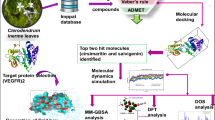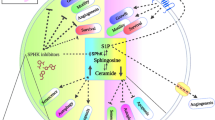Summary
Pancreatic cancer, the fourth leading cause of cancer death in the United States, has a negative prognosis because metastasis occurs before symptoms manifest. Although combination therapies are showing improvements in treatment, the survival rate for pancreatic cancer five years post diagnosis is only 8%, stressing the need for new treatments. The receptor for advanced glycation end products (RAGE) has recently emerged as a chemotherapeutic target in KRAS driven pancreatic cancers both for treatment and in chemoprevention. RAGE appears to be an important regulator of inflammatory, stress and survival pathways that lead to carcinogenesis, resistance to chemotherapy, enhanced proliferation and the high metastatic potential of pancreatic cancer. RAGE expression has been demonstrated in pancreatic cancer tumors but not in adjacent epithelial tissues. Its presence is associated with increased proliferation and metastasis. In an effort to identify novel inhibitors of RAGE among our collection of marine-derived secondary metabolites, a cell-based screening assay utilizing flow cytometry was developed. This effort led to the identification of scalarin as the active compound in a marine sponge identified as Euryspongia cf. rosea. Scalarin is a sesterterpene natural product isolated previously from a different marine sponge. Scalarin reduces the levels of RAGE and inhibits autophagy in the PANC-1 and MIA PaCa-2 pancreatic cancer cell lines. Its IC50 for cytotoxicity ranges between 20 and 30 μM in the AsPC-1, PANC-1, MIA PaCa-2 and BxPC-3 pancreatic cancer cell lines. Inhibition of autophagy limits tumor growth and tumorigenesis in pancreatic cancer, making scalarin an interesting compound that may merit further study.






Similar content being viewed by others
References
American Cancer Society. (2018) Cancer Facts and Figures. https://www.cancer.org/research/cancer-facts-statistics/all-cancer-facts-figures/cancer-facts-figures-2018.html Accessed (05/11/18)
Sims GP, Rowe DC, Rietdijk ST, Herbst R, Coyle AJ (2010) HMGB1 and RAGE in inflammation and cancer. Annu Rev Immunol 28:367–388
Han SH, Kim YH, Mook-Jung I (2011) RAGE: the beneficial and deleterious effects by diverse mechanisms of actions. Mol Cell 31(2):91–97
Bierhaus A, Humpert PM, Morcos M, Wendt T, Chavakis T, Arnold B, Stern DM, Nawroth PP (2005) Understanding RAGE, the receptor for advanced glycation end products. J Mol Med 83(11):876–886
Logsdon CD, Simeone DM, Binkley C, Arumugam T, Greenson JK, Giordano TJ, Misek DE, Kuick R, Hanash S (2003) Molecular profiling of pancreatic adenocarcinoma and chronic pancreatitis identifies multiple genes differentially regulated in pancreatic cancer. Cancer Res 63(10):2649–2657
Arumugam T, Simeone DM, Van Golen K, Logsdon CD (2005) S100P promotes pancreatic cancer growth, survival, and invasion. Clin Cancer Res 11(15):5356–5364. https://doi.org/10.1158/1078-0432.CCR-05-0092
Arumugam T, Simeone DM, Schmidt AM, Logsdon CD (2004) S100P stimulates cell proliferation and survival via receptor for activated glycation end products (RAGE). J Biol Chem 279(7):5059–5065
Arumugam T, Ramachandran V, Logsdon CD (2006) Effect of cromolyn on S100P interactions with RAGE and pancreatic cancer growth and invasion in mouse models. J Natl Cancer Inst 98(24):1806–1818. https://doi.org/10.1093/jnci/djj498
Sparvero LJ, Asafu-Adjei D, Kang R, Tang D, Amin N, Im J, Rutledge R, Lin B, Amoscato AA, Zeh HJ, Lotze MT (2009) RAGE (receptor for advanced glycation Endproducts), RAGE ligands, and their role in cancer and inflammation. J Transl Med 7:17
Takada M, Hirata K, Ajiki T, Suzuki Y, Kuroda Y (2004) Expression of receptor for advanced glycation end products (RAGE) and MMP-9 in human pancreatic cancer cells. Hepato-Gastroenterology 51(58):928–930
Takada M, Koizumi T, Toyama H, Suzuki Y, Kuroda Y (2001) Differential expression of RAGE in human pancreatic carcinoma cells. Hepato-Gastroenterology 48(42):1577–1578
Kang R, Tang D, Schapiro NE, Livesey KM, Farkas A, Loughran P, Bierhaus A, Lotze MT, Zeh HJ (2010) The receptor for advanced glycation end products (RAGE) sustains autophagy and limits apoptosis, promoting pancreatic tumor cell survival. Cell Death Differ 17(4):666–676. https://doi.org/10.1038/cdd.2009.149
Jiao L, Weinstein SJ, Albanes D, Taylor PR, Graubard BI, Virtamo J, Stolzenberg-Solomon RZ (2011) Evidence that serum levels of the soluble receptor for advanced glycation end products are inversely associated with pancreatic Cancer risk: a prospective study. Cancer Res
Krechler T, Jachymova M, Mestek O, Zak A, Zima T, Kalousova M (2010) Soluble receptor for advanced glycation end-products (sRAGE) and polymorphisms of RAGE and glyoxalase I genes in patients with pancreas cancer. Clin Biochem 43(10–11):882–886
Kang R, Tang D, Loze MT, Zeh HJ (2011) Apoptosis to autophagy switch triggered by the MHC class III-encoded receptor for advanced glycation endproducts (RAGE). Autophagy 7(1):91–93
Kang R, Tang D, Lotze MT, Zeh HJ, 3rd (2011) RAGE regulates autophagy and apoptosis following oxidative injury. Autophagy 7 (4)
Dalby KN, Tekedereli I, Lopez-Berestein G, Ozpolat B (2010) Targeting the prodeath and prosurvival functions of autophagy as novel therapeutic strategies in cancer. Autophagy 6(3):322–329
Yang S, Wang X, Contino G, Liesa M, Sahin E, Ying H, Bause A, Li Y, Stommel JM, Dell'antonio G, Mautner J, Tonon G, Haigis M, Shirihai OS, Doglioni C, Bardeesy N, Kimmelman AC (2011) Pancreatic cancers require autophagy for tumor growth. Genes Dev 25(7):717–729
Fujii S, Mitsunaga S, Yamazaki M, Hasebe T, Ishii G, Kojima M, Kinoshita T, Ueno T, Esumi H, Ochiai A (2008) Autophagy is activated in pancreatic cancer cells and correlates with poor patient outcome. Cancer Sci 99(9):1813–1819
Mayer AMS (2012) 16. Marine pharmacology and the late 2011 marine pharmaceuticals pipeline. Toxicon 60(2):104. https://doi.org/10.1016/j.toxicon.2012.04.017
Cimino G, De Stefano S, Minale L, Trivellone E (1977) 12-epi-scalarin and 12-epi-deoxoscalarin, Sesterterpenes from the sponge Spongia nitens. J Chem Soc Perkin Trans 1(13):1587–1593
Kallifatidis G, Hoepfner D, Jaeg T, Guzman EA, Wright AE (2013) The marine natural product manzamine a targets vacuolar ATPases and inhibits autophagy in pancreatic cancer cells. Mar Drugs 11(9):3500–3516. https://doi.org/10.3390/md11093500
Lin J, Tang Y, Kang Q, Feng Y, Chen A (2012) Curcumin inhibits gene expression of receptor for advanced glycation end-products (RAGE) in hepatic stellate cells in vitro by elevating PPARgamma activity and attenuating oxidative stress. Br J Pharmacol 166(8):2212–2227. https://doi.org/10.1111/j.1476-5381.2012.01910.x
Fattorusso E, Magno S, Santacroce C, Sica D (1972) Scalarin, a new pentacyclic C-25 terpenoid from the sponge Cacospongia scalaris. Tetrahedron 28:5993–5997
Pettit GR, Cichacz A, Tan R, Hoard MS, Melody N, Pettit R (1998) Antineoplastic agents. 386. Isolation of sesterstatins 1-3 from the marine sponge Hyrtios erecta. J Nat Prod 61(1):13–16. https://doi.org/10.1021/np970203+
Lee Y-J, Lee J-W, Lee D-G, Lee H-S, Kang JS, Yun J (2014) Cytotoxic sesterterpenoids isolated from the marine sponge Scalarispongia sp. Int J Mol Sci 15(11):20045–20053
Tsukamoto S, Miura S, van Soest RW, Ohta T (2003) Three new cytotoxic sesterterpenes from a marine sponge Spongia sp. J Nat Prod 66(3):438–440. https://doi.org/10.1021/np020497l
Guzman EA, Johnson JD, Linley PA, Gunasekera SE, Wright AE (2011) A novel activity from an old compound: Manzamine a reduces the metastatic potential of AsPC-1 pancreatic cancer cells and sensitizes them to TRAIL-induced apoptosis. Investig New Drugs 29(5):777–785. https://doi.org/10.1007/s10637-010-9422-6
Yang A, Herter-Sprie G, Zhang H, Lin EY, Biancur D, Wang X, Deng J, Hai J, Yang S, Wong KK, Kimmelman AC (2018) Autophagy sustains pancreatic Cancer growth through both cell-autonomous and nonautonomous mechanisms. Cancer Discov 8(3):276–287. https://doi.org/10.1158/2159-8290.CD-17-0952
Guzman EA, Harmody D, Pitts TP, Vera-Diaz B, Winder PL, Yu Y, Wright AE (2017) Inhibition of IL-8 secretion on BxPC-3 and MIA PaCa-2 cells and induction of cytotoxicity in pancreatic cancer cells with marine natural products. Anti-Cancer Drugs 28(2):153–160. https://doi.org/10.1097/CAD.0000000000000443
Acknowledgements
Funding for this project was provided by the National Institutes of Health R21CA176222 awarded to Dr. Guzmán. Research Excellence funds from the Harbor Branch Oceanographic Institute Foundation (HBOIF) awarded to Dr. Guzmán and Dr. Wright contributed to finalizing this publication. We thank Dr. Peter McCarthy for proofreading the article. This is HBOI contribution number 2167.
Funding
This study was funded by the National Institutes of Health R21CA176222.
Author information
Authors and Affiliations
Corresponding author
Ethics declarations
Only invertebrate not-sentient marine sponges were used in this study. Projects using invertebrates are not subject to review by the Institutional Animal Care and Use Committee of Florida Atlantic University. This article does not contain studies with human participants or vertebrate animals performed by any of the authors.
Conflict of interest
All authors—Guzmán, Pitts, Diaz and Wright—declare that they have no conflicts of interest.
Rights and permissions
About this article
Cite this article
Guzmán, E.A., Pitts, T.P., Diaz, M.C. et al. The marine natural product Scalarin inhibits the receptor for advanced glycation end products (RAGE) and autophagy in the PANC-1 and MIA PaCa-2 pancreatic cancer cell lines. Invest New Drugs 37, 262–270 (2019). https://doi.org/10.1007/s10637-018-0635-4
Received:
Accepted:
Published:
Issue Date:
DOI: https://doi.org/10.1007/s10637-018-0635-4




